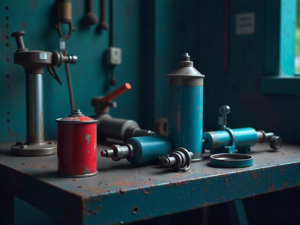Let’s be honest—there’s nothing more frustrating than a machine that stops working right in the middle of production. One seized bearing or a sticky gear can bring an entire operation to a halt. That’s why proper lubrication isn’t just a nice-to-have—it’s a must. But here’s the kicker: using the wrong lubrication tool can make things worse, wasting time, material, and sometimes even damaging the equipment.
What Are Lubrication Tools?
So, what are lubrication tools? In simple terms, they are the devices that get grease, oil, or other lubricants onto your machinery’s moving parts. Think of them as the bridge between the lubricant in the container and the parts that need it most. They reduce friction, prevent wear, and protect metal surfaces from rust. Done right, they keep your machines running smoother and longer. Done wrong, and you’re just adding headaches.
Why Proper Lubrication Matters
Some people think lubrication is just “oiling things up.” But it’s much more than that. Good lubrication:
- Cuts down friction so parts don’t wear out quickly.
- Helps components stay cool under heavy use.
- Extends the lifespan of costly equipment.
- Keeps everything running efficiently, which means fewer unexpected stoppages.
Skip it or do it poorly, and you’re looking at downtime, expensive repairs, and frustrated workers.
Picking the Right Lubrication Tool
Now here’s where many people get tripped up. Not every tool works for every job. Choosing the right one depends on a few key factors.
- What Kind of Lubricant You’re Using
Different lubricants need different tools. If you’re using grease on bearings or joints, a grease gun works best. Oils are better for engines and gear systems, often applied via oil cans or pumps. And sometimes dry lubricants are your only option, like in dusty or wet environments. Know your lubricant before you choose the tool—it makes life a lot easier. - How You Apply It
There are several ways to get lubricant onto parts:
Manual tools: Grease guns and oil cans let you apply precisely but require elbow grease.
- Pneumatic tools: These use air pressure, making lubrication faster and more consistent.
- Automatic systems: These deliver lubricant on a schedule, perfect for busy operations where human error can sneak in.
Think about how often you need lubrication and how much time your team has.
- Accessibility
Some parts are easy to reach, others aren’t. Manual tools work fine for open spots, but for tight corners or hidden bearings, you’ll need flexible hoses or extension nozzles. Skipping these areas is a recipe for uneven lubrication—and eventually, failure. - Volume and Frequency
How much lubricant do you need, and how often? High-volume jobs might call for bucket grease pumps or rotary barrel pumps. If lubrication is frequent, automatic systems save time and keep things consistent. The wrong choice here can mean over-lubrication, under-lubrication, or a mess on the floor. - Environment
Your tools also need to survive the environment. High heat? Make sure your lubricants and tools can handle it. Dusty or wet? Look for sealed or enclosed systems to prevent contamination. Choosing the right tool for the environment protects both your machinery and the lubricant itself.
Common Lubrication Tools
Here’s a quick rundown of tools people use most often:
- Grease guns: Great for bearings, joints, and steering parts. Available in manual or pneumatic versions.
- Oil cans: Good for small motors, sewing machines, or bicycles, especially when precision is needed.
- Caulking guns: Useful for thick lubricants or sealants, often in automotive applications.
- Suction guns: Handy for adding or removing fluids from gearboxes and hydraulic systems.
- Bucket grease pumps: Perfect for high-volume industrial lubrication.
- Rotary barrel pumps: Efficient for transferring oils or grease from large barrels.
Tips for Better Lubrication
Here’s the advice that saves people headaches:
- Keep a routine. Don’t guess—stick to manufacturer recommendations.
- Train your team. Even the best tool fails if used incorrectly.
- Use quality lubricants. Cheap grease or oil can do more harm than good.
- Check your results. Make sure lubrication reaches the right parts and adjust if needed.
Even small tweaks to how you lubricate can prevent major downtime and expensive repairs.
Final Thoughts
Lubrication isn’t just another maintenance task—it’s an investment in the life of your machinery. Choosing the right lubrication tool is just as important as picking the right lubricant. Think about the type of lubricant, how it’s applied, accessibility, volume, frequency, and environmental conditions. Do it right, and your machines will run smoother, longer, and with fewer surprises.







